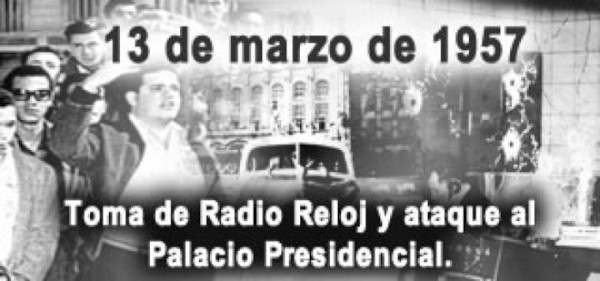
March 13, 1957 is registered in the history of Cuba as a glorious date, in spite of the fact that the historical event that marked that day was not as successful as expected by its protagonists and the student leader Jose Antonio Echeverria was assassinated.
That day a commando of the Revolutionary Directorate, the armed wing of the University Student Federation (FEU), stormed the Presidential Palace and briefly occupied the capital's Radio Reloj radio station, which by then had a large national audience.
An important objective in bursting into the seat of the usurper government, occupied since March 10, 1952 by the coup plotter and murderer Fulgencio Batista, was to execute the tyrant, a man who daily plunged Cuba into pain with criminal and torturing cruelty.
But the conception was more comprehensive and far-reaching in relation to its aims, since it also aspired to generate popular insurrection initiated from the delivery of weapons to the people, to turn it into a boomerang or revolutionary tide of great force, capable of putting an end to the regime that surrendered the country's wealth.
The secret plan was to continue, if the first part was fulfilled, to the University of Havana and from there to take a cache of weapons prepared for the occasion and deliver them to the population, who were to learn the news of the dictator's death through a speech made by the enraged president of the FEU from the national radio station.
When he was able to enter the radio station, Jose Antonio did not know that the carefully planned action of the Palace could not be fulfilled and he could only speak briefly through the ether in a broadcast not very listened to or remembered then, although fortunately it was recorded for history.
Several causes influenced the failure of the operation, which began at approximately three o'clock in the afternoon of that day, since it was necessary to count on the additional support of a truck with armaments supplied on site, but its driver lost his way.
The surprise factor also failed because the vanguard command that was supposed to access the president's office, where it was traditional to find him at that hour, was disconcerted when he was apparently absent by chance.
In this context, Carlos Gutierrez was mortally wounded in a fierce confrontation that the presidential garrison quickly engaged in.
Seeing that the mission would not be accomplished there, Jose Machado (Machadito) gave the order to withdraw, delayed when he realized that Juan Pedro Carbo Servia had not appeared and returned to look for him inside the building.
When he left Radio Reloj, Jose Antonio Echeverria went in a car to the University, relatively close. In transit he was intercepted by a patrol car, identified and cowardly shot in an incident in which the young leader showed once again his courage and determination to fight.
His assassination took place in a street close to the educational center, so the young hero died very close to the places that witnessed his constant actions in favor of the student revolutionary movement and Cuba.
That event, which took place while the armed struggle led by Fidel Castro was gaining strength in the Sierra Maestra, did not represent a break in the patriotic climate that was gaining intensity.
Before the fateful March 13, in which other valuable young soldiers also fell, Jose Antonio Echeverria and Fidel had signed in exile the so-called Letter of Mexico, where they confirmed the unity of principles and intentions of unitary collaboration between both patriotic forces.
So the brilliant architecture student and his fellow board members were responding to a commitment, and were also aware that the growing political and mobilizing environment in the country, mainly led by young people, had close synergy with their objectives, as well as their actions in others.
It was time to march in a tight frame, despite the specificities of the component elements.
In spite of the setback, that action represented a sample of the moral growth in the virtues of the Cuban youth and people, together with the armed struggle in the Sierra Maestra.
The unforgettable Jose Antonio Echeverria was born on July 16, 1932 in the western city of Cardenas, belonging to the province of Matanzas, and was one of the most charismatic and pure heroes in his way through the educational centers where he was educated.
However, it was from the University of Havana that he showed his courage at the national and even regional level, by participating in student events in Central America and as president of the legendary FEU from 1954 to 1957.
Shortly before falling in combat, he said, in view of the possible risk of losing his life in the revolutionary struggle, that it was not important if his dedication helped to raise awareness in others. Cuba has always honored and exalted him with great admiration.
Sidebar

 Agencia Cubana de Noticias
Líder en información nacional
Agencia Cubana de Noticias
Líder en información nacional








Nos reservamos el derecho de no publicar los comentario que incumplan con las normas de este sitio